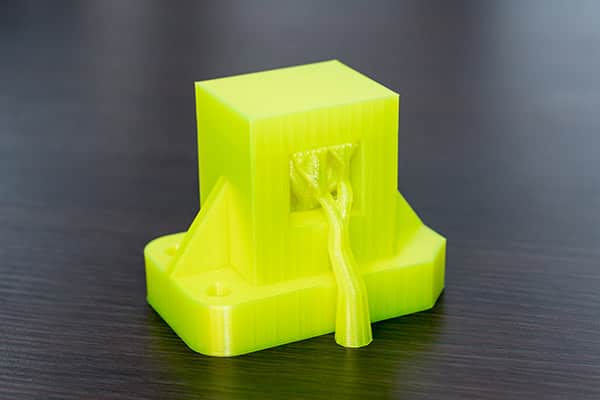Intro
Material selection is often the most important part of making the best 3D printed parts. As you look around, you’ll notice a ton of different materials that offer different results. A popular lane of materials is thermoplastics.
The two major types of 3D printing are Fused Deposition Modeling (FDM) and Selective Laser Sintering (SLS). We broke this guide into two parts to talk about each of these styles of 3D printing and discuss the best thermoplastic material options for both.
Thermoplastic Material Options for FDM
When people think of “traditional” 3D printing, FDM is typically the option they think of. As a reminder, this is when a printer uses a moving head to extrude hot material, one layer at a time.
These thermoplastic materials are fed into the extruder head of the printer.
PLA
Perhaps the most common thermoplastic material for FDM is PLA. This is most printers’ go-to material.
It’s low-cost, easy to work with, and the temperature requirements are really low. Manufacturers have a ton of interesting color options for PLA’s — from standard colors to glow-in-the-dark options to your favorite fluorescent colors.
It’s one of the best materials to make prototypes with, for the reasons listed above.
ABS
ABS is a stronger option as compared to PLA. It’s a more durable material that is a little harder to print than PLA. Still, it’s easy for a first-time printer to make an ABS part with no problem.
The material is still inexpensive, but the temperature requirements are a little higher than PLA.
Polycarbonate
One of the more serious thermoplastics on the market for FDM printers is polycarbonate. This is the same type of plastic that’s used to make bulletproof glass.
This material is preferred when strength is required. It also withstands a lot of heat — a trait that’s uncommon in the world of FDM-printed parts.
Printing with PC can be difficult for the beginner printer. With the right parameters, the parts can have incredible accuracy and precision.
Polycarbonate is typically used for working prototypes or low-run production parts.
Nylon 6
Nylon 6 from FDM printers can be found in aerospace, automotive, and even consumer applications.
They are very strong and can withstand rigorous cyclic loading without failure.
It’s not nearly as flexible as the Nylon 6/6 tubing you’re used to, or as firm as Nylon 12 printed material. It fills the gap in flexibility between these two.
ULTEM 1010
ULTEM 1010 is a very unique material in 3D printing. It offers the highest tensile strength, heat resistance, and chemical resistance of any other FDM thermoplastic on the market.
In addition, it’s the only NSF 51 food-contact certified material for FDM printing, and it offers biocompatibility through ISO 10993/USP Class VI certs.
This is used in extreme environments where performance is paramount.
ANTERO
ANTERO is a brand-name FDM thermoplastic that incorporates PEKK. This material has incredible strength, wear-resistance, and toughness. All the while, it has the versatility of a 3D-printed material.
It’s properties are stronger than ABS or Nylon 6, for reference. People use ANTERO when they want a high-strength print that can be used as a functioning prototype or full-time production part.
Thermoplastic Material Options for SLS
Another common form of 3D printing is SLS. This is when a laser passes over a trough of dust material that moves awayfrom the laser head. The laser sinters and bonds the dust to one another, creating a solid part.
These types of thermoplastics are used as the dust material in the trough.
Nylon 11
Nylon 11 is a more flexible thermoplastic, similar to Nylon 6/6 tubing.
It is preferred for high-strength applications where performance and durability really matter.
Since it has a level of flexibility, it can bend without snapping — a common issue with more firm and brittle material options. It can elongate up to 40% before breaking.
Many engineers use it to create fixtures or jigs that need to be impact-resistant while still performing its function.
For example, you could use Nylon 11 as a thin-walled enclosure to use in your manufacturing process.
Nylon 12
As we mentioned earlier, Nylon 12 is a very ductile material that is much more firm than the other Nylon options. It’s the preferred method for applications that require high strength accuracy.
Due to its stronger nature, it works better than Nylon 11 when it comes to permanent parts and jigs.
If you want a high-performance prototype, an SLS-printed Nylon 12 part might be perfect.
Elastomeric Thermoplastics
“Elastomeric thermoplastics” is a more general term. It’s a group of plastics that are especially flexible and rubber-like in nature. DuraForm makes two popular options: one is a TPU and the other is their FLEX thermoplastic.
These are great options if you want to manufacture prototypes with rubber-like properties. They can be squished and absorb impact while still being comfortable enough for consumer use.
In manufacturing industries, they can be used as a gasket, seal, or hose. Since it’s a 3D printable material, it can be completely customized to your application.
Conclusion
There are a number of thermoplastic material options that are available for 3D printing. We reviewed some common examples in FDM and SLS. If you’d like to know the right solution for your application, reach out to Rapid Axis today. We can handle your 3D printing needs and deliver the perfect products.

